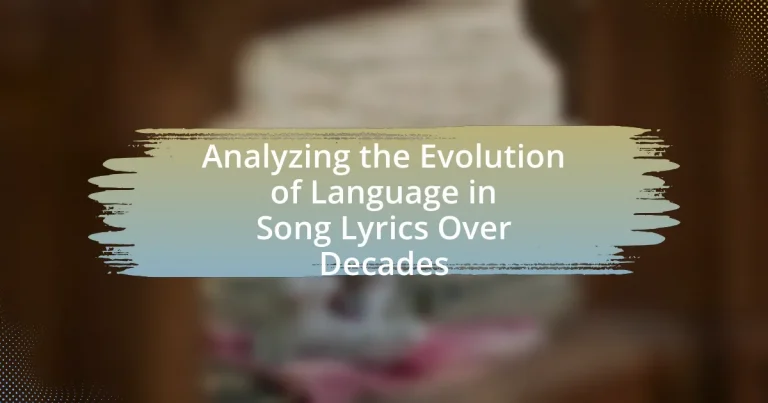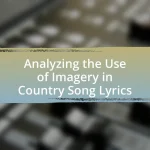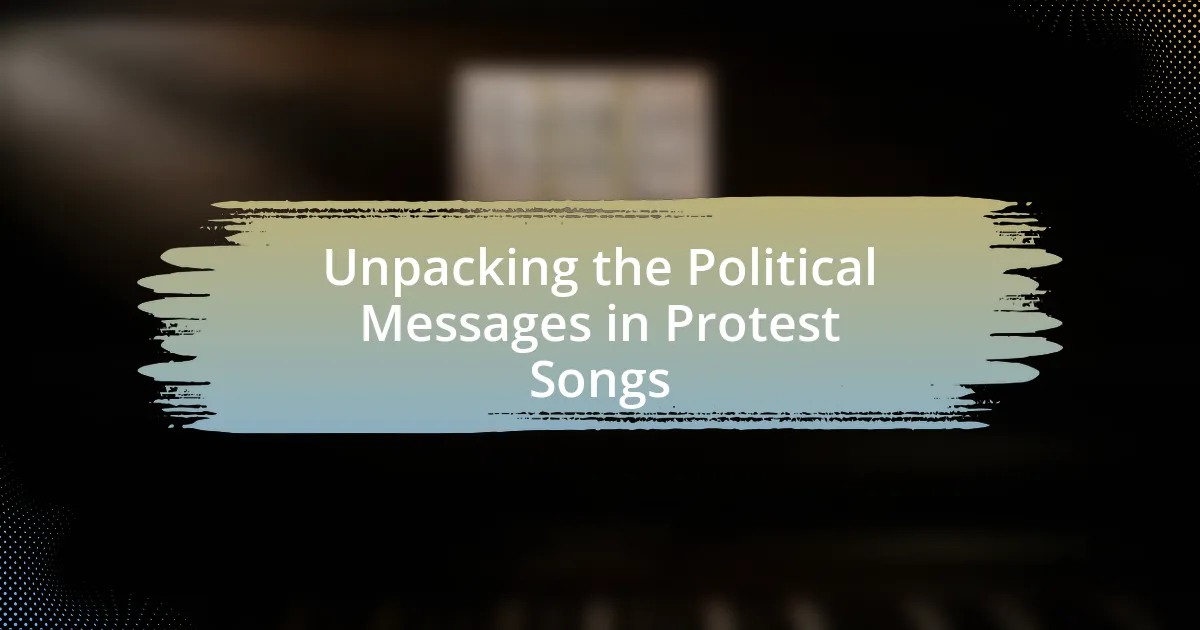The article examines the evolution of language in song lyrics over the decades, highlighting how cultural and societal changes have influenced lyrical content. It traces the transition from simple themes in early 20th-century ballads to the complex narratives and diverse vocabulary found in contemporary music. Key linguistic features such as the use of colloquial language, metaphor, and storytelling are analyzed, alongside the impact of social movements and technological advancements on lyrical expression. The article emphasizes the importance of analyzing song lyrics to gain insights into societal values and emotional landscapes, while also discussing methods and challenges in lyrical analysis.
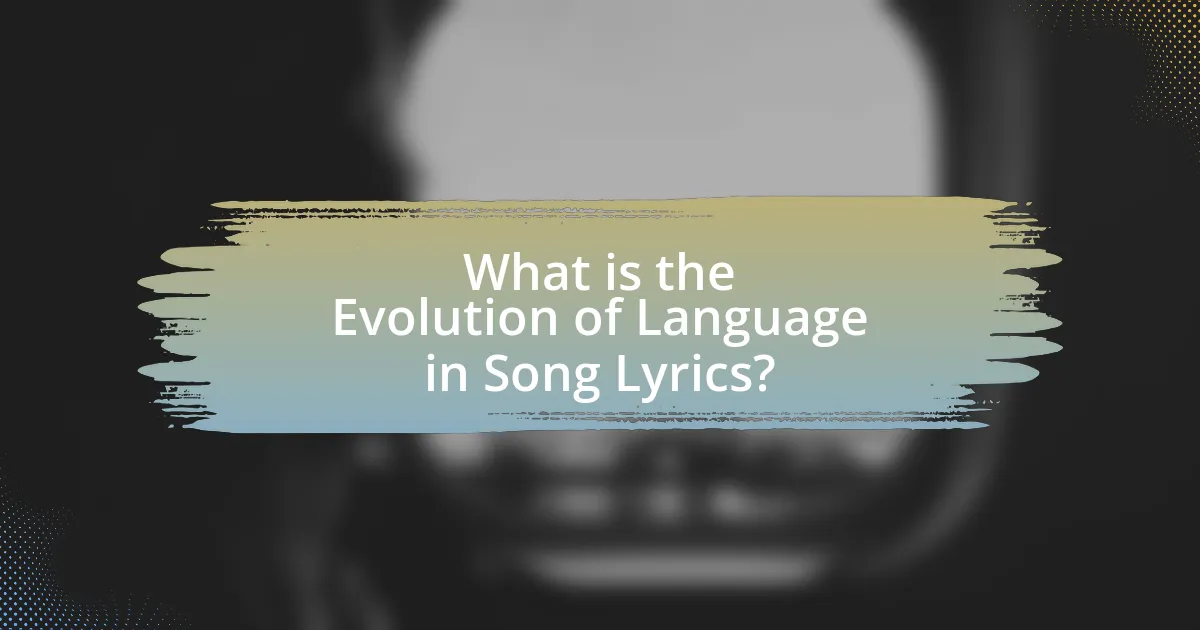
What is the Evolution of Language in Song Lyrics?
The evolution of language in song lyrics reflects significant cultural and societal changes over time. Initially, song lyrics were often simple and focused on universal themes such as love and nature, using straightforward language. As music genres diversified, particularly in the 20th century, lyrics began to incorporate more complex vocabulary and themes, influenced by social movements, technological advancements, and cultural shifts. For example, the emergence of rock and hip-hop introduced slang and colloquial expressions, making lyrics more relatable to younger audiences. Additionally, the use of metaphor and storytelling became prevalent, allowing artists to convey deeper meanings and emotions. This linguistic evolution is evidenced by the transition from the straightforward ballads of the early 1900s to the intricate narratives found in contemporary music, showcasing how language adapts to reflect the zeitgeist of each era.
How has language in song lyrics changed over the decades?
Language in song lyrics has evolved significantly over the decades, reflecting broader cultural and societal changes. In the 1950s and 1960s, lyrics often focused on themes of love and innocence, using straightforward language and simple rhyme schemes, as seen in the works of artists like Elvis Presley and The Beatles. By the 1970s and 1980s, lyrics began to incorporate more complex themes, including social issues and personal struggles, with artists like Bob Dylan and Bruce Springsteen using metaphor and storytelling techniques.
The 1990s and 2000s saw a rise in the use of slang, colloquialisms, and explicit language, particularly in genres like hip-hop and grunge, with artists such as Tupac Shakur and Nirvana pushing boundaries. In recent years, lyrics have increasingly embraced diversity in language, incorporating multilingual elements and addressing contemporary issues like mental health and identity, as exemplified by artists like Billie Eilish and Bad Bunny. This progression illustrates how song lyrics have transitioned from simple expressions of emotion to complex narratives that engage with the realities of modern life.
What are the key linguistic features that have evolved in song lyrics?
Key linguistic features that have evolved in song lyrics include increased use of colloquial language, diverse vocabulary, and narrative complexity. Over the decades, songwriters have shifted from formal and poetic structures to more conversational tones, reflecting everyday speech patterns. For instance, the rise of hip-hop and pop genres has introduced slang and informal expressions, making lyrics more relatable to contemporary audiences. Additionally, the complexity of narratives in lyrics has grown, with artists often weaving intricate stories and emotional depth, as seen in works by artists like Taylor Swift and Kendrick Lamar. This evolution mirrors broader societal changes and the influence of digital communication, which has fostered a more personal and direct connection between artists and listeners.
How do cultural shifts influence language in song lyrics?
Cultural shifts significantly influence language in song lyrics by introducing new themes, slang, and expressions that reflect societal changes. For instance, the rise of social movements, such as feminism and LGBTQ+ rights, has led to the incorporation of inclusive language and diverse narratives in contemporary music. Historical examples include the shift in language during the civil rights movement of the 1960s, where artists like Bob Dylan and Nina Simone used their lyrics to address social justice issues, thereby altering the lyrical landscape to resonate with the evolving cultural context. This dynamic interaction between culture and language in music illustrates how artists adapt their expressions to mirror the values and experiences of their audiences.
Why is it important to analyze language in song lyrics?
Analyzing language in song lyrics is important because it reveals cultural, social, and emotional contexts that shape and reflect societal values. The language used in lyrics often mirrors the evolution of vernacular, idioms, and themes prevalent in specific time periods, providing insights into historical and contemporary issues. For instance, a study by the University of California, Berkeley, found that the vocabulary in popular music has shifted significantly over the decades, indicating changing societal norms and attitudes. This analysis helps in understanding how artists communicate complex ideas and emotions, making it a valuable tool for both linguistic and cultural studies.
What insights can we gain about society from song lyrics?
Song lyrics provide valuable insights into societal values, cultural shifts, and emotional landscapes. They reflect the prevailing attitudes and issues of their time, such as social justice, love, and political unrest. For example, the protest songs of the 1960s, like Bob Dylan’s “The Times They Are a-Changin’,” highlight the civil rights movement and anti-war sentiments, showcasing how music can serve as a barometer for societal change. Additionally, contemporary lyrics often address themes like mental health and identity, indicating a growing awareness and acceptance of these issues in modern society. This evolution in lyrical content illustrates how songwriters respond to and influence public discourse, making lyrics a rich source for understanding societal dynamics.
How does language in song lyrics reflect the emotions of different eras?
Language in song lyrics reflects the emotions of different eras by capturing the cultural, social, and political sentiments prevalent during those times. For instance, the romanticism and idealism of the 1960s counterculture are evident in songs like “All You Need Is Love” by The Beatles, which emphasized peace and love amidst social upheaval. In contrast, the angst and disillusionment of the 1990s grunge movement are encapsulated in Nirvana’s “Smells Like Teen Spirit,” which expressed feelings of apathy and rebellion against mainstream culture. These shifts in language and themes in lyrics correspond to historical events, such as the civil rights movement or economic recessions, illustrating how artists articulate the collective emotional landscape of their eras.
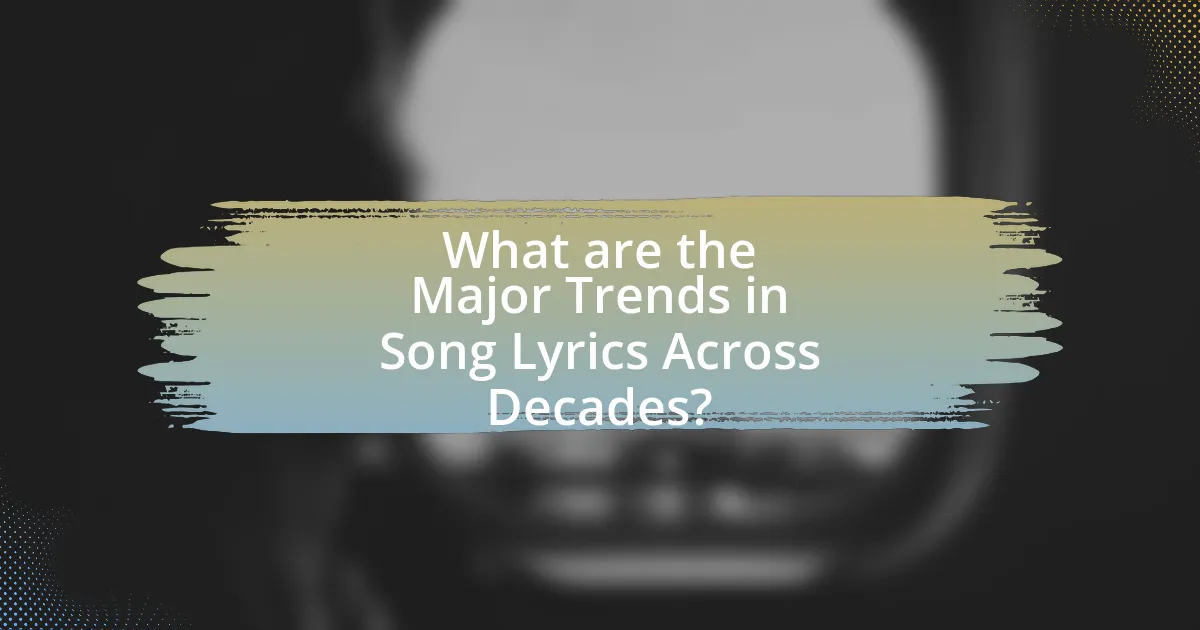
What are the Major Trends in Song Lyrics Across Decades?
Major trends in song lyrics across decades include the evolution from simple, romantic themes in the 1950s to complex social and political commentary in the 1960s and 1970s, followed by a focus on personal identity and emotional expression in the 1980s and 1990s. In the 2000s and 2010s, lyrics increasingly incorporated digital culture and social media influences, reflecting contemporary issues such as mental health and social justice. For instance, the 1960s saw artists like Bob Dylan using lyrics to address civil rights and anti-war sentiments, while the 1990s featured grunge bands like Nirvana exploring themes of alienation and existential angst. The shift towards digital culture is evident in the rise of genres like hip-hop and pop, where artists like Drake and Billie Eilish address modern anxieties and experiences.
How did the language of the 1960s differ from that of the 1970s?
The language of the 1960s differed from that of the 1970s primarily in its thematic focus and stylistic elements. In the 1960s, song lyrics often emphasized social and political issues, reflecting the counterculture movement, civil rights, and anti-war sentiments, as seen in songs like Bob Dylan’s “The Times They Are a-Changin’.” In contrast, the 1970s saw a shift towards more personal and introspective themes, with artists like Carole King and Elton John exploring individual emotions and relationships, as exemplified in King’s “You’ve Got a Friend.” This transition illustrates a broader cultural shift from collective activism to personal expression in music.
What themes were prevalent in the 1960s lyrics?
The prevalent themes in 1960s lyrics included social change, love and relationships, political activism, and counterculture. Artists like Bob Dylan and Joan Baez addressed civil rights and anti-war sentiments, reflecting the era’s turbulence and desire for change. The Beatles and The Beach Boys explored love and personal relationships, while the rise of psychedelic rock introduced themes of consciousness and experimentation. These themes were significant as they mirrored the societal shifts occurring during the decade, such as the civil rights movement and the Vietnam War protests, making the lyrics a powerful reflection of the time.
How did the 1970s introduce new linguistic styles in music?
The 1970s introduced new linguistic styles in music through the incorporation of diverse genres and the use of colloquial language, reflecting social changes and cultural movements. Artists like Bob Dylan and The Beatles began to experiment with storytelling and personal narratives, moving away from traditional song structures. The rise of genres such as funk, punk, and hip-hop further diversified lyrical content, emphasizing themes of rebellion, identity, and social commentary. For instance, the emergence of hip-hop in the late 1970s showcased rhythmic spoken word and street vernacular, which transformed the way language was used in music. This period marked a significant shift towards more authentic and relatable expressions in lyrics, aligning with the counterculture movements of the time.
What role did technology play in the evolution of song lyrics?
Technology significantly influenced the evolution of song lyrics by enabling new forms of expression and accessibility. The advent of recording technology in the early 20th century allowed artists to reach wider audiences, which in turn encouraged experimentation with lyrical themes and styles. For instance, the introduction of electric instruments and synthesizers in the 1960s and 1970s led to the emergence of genres like rock and electronic music, which often featured more complex and abstract lyrics. Additionally, the internet and digital platforms have democratized music distribution, allowing diverse voices and lyrical content to flourish, as seen in the rise of hip-hop and indie music. This shift has resulted in a broader range of topics being explored in lyrics, reflecting societal changes and cultural movements.
How did the advent of digital music impact lyrical content?
The advent of digital music significantly transformed lyrical content by enabling greater accessibility and diversity in themes. Digital platforms allowed artists to reach wider audiences, leading to an increase in experimentation with language and subject matter. For instance, the rise of streaming services and social media has encouraged artists to explore niche topics and personal narratives, reflecting contemporary issues such as mental health, identity, and social justice. This shift is evidenced by the popularity of genres like hip-hop and indie music, which often feature introspective and socially conscious lyrics, contrasting with the more traditional themes prevalent in earlier music formats.
What changes occurred in songwriting due to social media influence?
Social media has significantly transformed songwriting by enabling direct artist-audience interaction and fostering real-time feedback. This shift allows songwriters to gauge listener preferences instantly, leading to more personalized and relatable lyrics. For instance, platforms like Twitter and Instagram have encouraged artists to share snippets of their work, creating a collaborative environment where fans can influence song direction. Additionally, the rise of viral trends on platforms like TikTok has prompted songwriters to craft hooks that are catchy and easily shareable, reflecting the brevity and immediacy of social media content. This evolution in songwriting emphasizes engagement and adaptability, aligning with the fast-paced nature of digital communication.
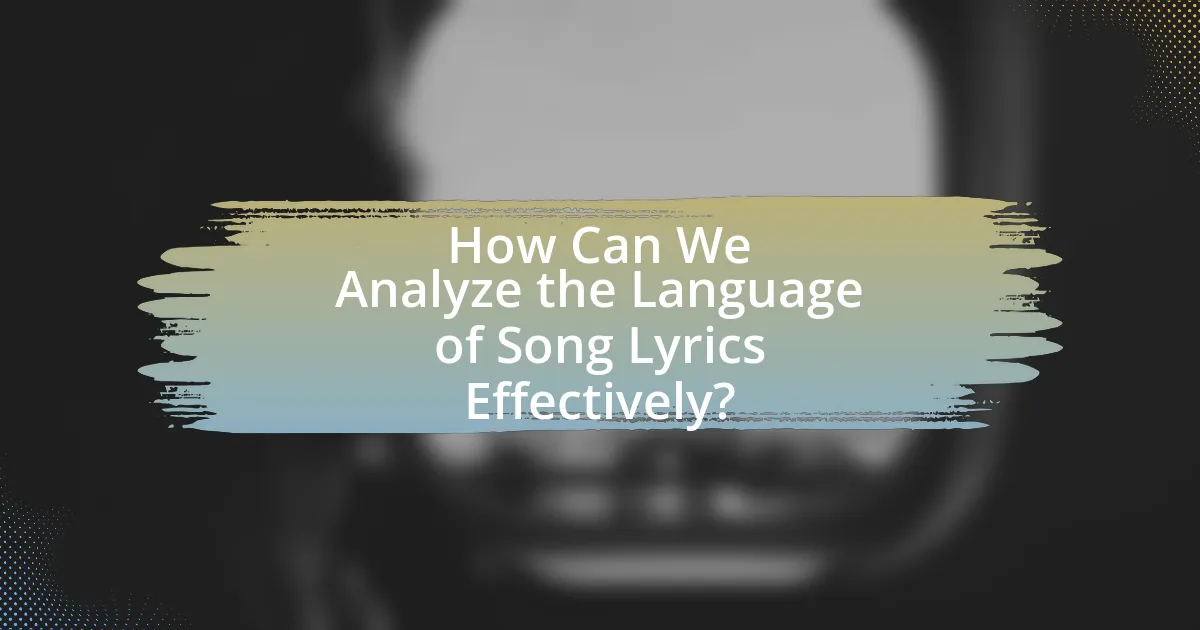
How Can We Analyze the Language of Song Lyrics Effectively?
To analyze the language of song lyrics effectively, one should employ a systematic approach that includes linguistic analysis, thematic exploration, and contextual understanding. Linguistic analysis involves examining the choice of words, syntax, and figurative language used in the lyrics, which can reveal the emotional tone and stylistic elements of the song. Thematic exploration focuses on identifying recurring motifs and messages, allowing for a deeper understanding of the artist’s intent and cultural commentary. Contextual understanding requires considering the historical and social background of the song, as well as the artist’s biography, which can provide insights into the influences shaping the lyrics. This multi-faceted approach ensures a comprehensive analysis that captures the complexity of language in song lyrics.
What methods are used to study language in song lyrics?
Methods used to study language in song lyrics include qualitative analysis, quantitative analysis, and computational linguistics. Qualitative analysis involves examining themes, metaphors, and stylistic elements within the lyrics to understand their cultural and emotional significance. Quantitative analysis employs statistical techniques to analyze word frequency, rhyme schemes, and syllable counts, providing insights into trends over time. Computational linguistics utilizes algorithms and natural language processing tools to analyze large datasets of lyrics, enabling researchers to identify patterns and shifts in language use across different genres and decades. These methods collectively contribute to a comprehensive understanding of how language in song lyrics evolves.
How do qualitative and quantitative analyses differ in this context?
Qualitative and quantitative analyses differ in the context of analyzing the evolution of language in song lyrics over decades primarily in their approach and outcomes. Qualitative analysis focuses on the subjective interpretation of lyrics, examining themes, emotions, and cultural significance, which allows for a deeper understanding of the context and meaning behind the words. In contrast, quantitative analysis employs statistical methods to measure specific linguistic features, such as word frequency, sentiment scores, or the prevalence of certain phrases over time, providing objective data that can reveal trends and patterns in language use. For instance, a qualitative analysis might explore how societal changes influence lyrical themes, while a quantitative analysis could track the increase in the use of specific slang terms across decades, illustrating the shift in language.
What tools are available for analyzing lyrical language?
Tools available for analyzing lyrical language include Natural Language Processing (NLP) software, sentiment analysis tools, and text mining applications. NLP software, such as NLTK and SpaCy, allows researchers to process and analyze text data, extracting linguistic features and patterns. Sentiment analysis tools, like VADER and TextBlob, evaluate the emotional tone of lyrics, providing insights into the sentiments expressed over time. Text mining applications, such as RapidMiner and KNIME, enable users to uncover trends and themes in large datasets of song lyrics, facilitating the study of language evolution in music. These tools collectively enhance the understanding of lyrical language by providing quantitative and qualitative analyses.
What are the challenges in analyzing song lyrics?
Analyzing song lyrics presents several challenges, primarily due to the complexity of language, cultural context, and subjective interpretation. The intricacies of figurative language, such as metaphors and similes, can obscure meaning, making it difficult to derive a singular interpretation. Additionally, cultural references and idiomatic expressions may vary significantly across different demographics, complicating the analysis further. For instance, a lyric that resonates with one generation may be lost on another due to changing societal norms and values. Furthermore, the emotional and personal nature of music means that listeners often bring their own experiences into their interpretations, leading to a wide range of subjective meanings. These factors collectively hinder a standardized approach to analyzing song lyrics, as evidenced by studies that highlight the variability in interpretation among different listener groups.
How do subjective interpretations affect lyrical analysis?
Subjective interpretations significantly influence lyrical analysis by allowing diverse meanings to emerge from the same text. Each listener’s personal experiences, cultural background, and emotional state shape their understanding of lyrics, leading to varied interpretations. For instance, a song’s themes of love may resonate differently with someone who has experienced heartbreak compared to someone in a happy relationship. This variability is supported by research indicating that individual context plays a crucial role in how art is perceived, as highlighted in studies on music psychology. Therefore, subjective interpretations enrich lyrical analysis by introducing multiple perspectives, enhancing the depth and complexity of understanding song lyrics.
What limitations exist in linguistic studies of song lyrics?
Linguistic studies of song lyrics face several limitations, primarily due to the subjective nature of interpretation and the cultural context of language. The ambiguity in lyrics can lead to multiple interpretations, making it difficult to establish a definitive linguistic analysis. Additionally, song lyrics often employ non-standard grammar, slang, and idiomatic expressions that may not align with formal linguistic frameworks, complicating the analysis. Furthermore, the influence of music genre and artist intent can skew linguistic findings, as different genres may prioritize lyrical content differently. These factors collectively hinder the ability to draw universally applicable conclusions about language evolution in song lyrics.
What practical tips can enhance the analysis of song lyrics?
To enhance the analysis of song lyrics, one practical tip is to examine the historical and cultural context in which the song was written. Understanding the time period and societal influences can reveal deeper meanings and themes within the lyrics. For example, analyzing Bob Dylan’s “The Times They Are a-Changin'” in the context of the 1960s civil rights movement provides insight into its call for social change. Additionally, breaking down the lyrics into their structural components, such as rhyme schemes and metaphors, can help identify patterns and stylistic choices that contribute to the song’s overall impact. This method is supported by literary analysis techniques commonly used in poetry studies, which emphasize the importance of form and content in understanding artistic expression.
How can one effectively identify linguistic trends in song lyrics?
One can effectively identify linguistic trends in song lyrics by employing text analysis techniques, such as natural language processing (NLP) and sentiment analysis. These methods allow researchers to quantify and categorize the language used in lyrics over time, revealing patterns in word choice, themes, and emotional tone. For instance, a study by J. P. D. M. de Vries and colleagues in 2020 utilized NLP to analyze over 100,000 song lyrics from the Billboard Hot 100, demonstrating shifts in vocabulary and sentiment across decades. This approach provides concrete evidence of how language evolves in popular music, reflecting broader cultural and societal changes.
What resources are recommended for deeper exploration of lyrical language?
Recommended resources for deeper exploration of lyrical language include “The Lyrics Handbook” by David W. Smith, which provides insights into the structure and meaning of song lyrics, and “Songwriting for Dummies” by Jim Peterik, which offers practical techniques for crafting lyrics. Additionally, the online platform Genius.com serves as a valuable resource for analyzing and annotating song lyrics, allowing users to explore interpretations and meanings. These resources collectively enhance understanding of lyrical language through structured analysis and practical application.
